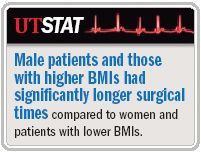Article
Hand-assisted donor nephrectomy presents challenges
Patient factors, level of surgeon training, and certain surgical steps appear to represent impediments to learning hand-assisted laparoscopic donor nephrectomy (HALDN).

Keypoints:



The organ removal portion of HALDN involves five individual steps: colon mobilization, kidney/ureter mobilization, renal vein tributary dissection, renal hilum dissection, and kidney removal. With the exception of kidney removal, the time needed to perform each of those steps was significantly associated with overall operative time. However, the correlations were strongest for colon mobilization and renal hilum dissection (r=.60, p<.01 for both).
"It was interesting to find that colon mobilization had the greatest impact on overall operative time. It is the first step learned in HALDN, and developing expertise with performing colon mobilization affects the surgeon's comfort with the overall procedure itself," Dr. Weizer said to Urology Times.
He added that the challenges encountered in performing colon mobilization and hilum dissection might be taken into account in the development of surgical simulators, residency programs, and mini-fellowship postgraduate training courses for teaching this advanced surgical technique.
Improvement, times vary
As expected, operative time decreased with increasing level of training. However, while the analyses demonstrated fairly rapid reductions in time needed to perform kidney/ureteral dissection as the number of cases performed increased, there was no improvement in operative time for colon mobilization. Time for kidney removal was short and stable, regardless of surgeon experience. Times for renal vein/tributary dissection, hilum dissection, and overall operative time were also stable, but showed greater variability. However, the variability was reduced with increasing surgeon experience.
"These findings may reflect both the inherent difficulty of some of the steps and the fact that others are initially straightforward so that there is little room for improvement," Dr. Weizer said.
Patient factors examined for their impact on operative time included age, gender, American Society of Anesthesiologists class, body mass index, and abnormal vasculature (based on the medical record). With patients stratified into three groups based on BMI, overall operative time increased as BMI increased, which was due to a significant increase in time for colon mobilization in heavier patients. There was also a trend for surgical time to be significantly longer in male versus female patients, which was accounted for by a significant increase in time needed to perform hilum dissection in males.
The investigators postulate that these associations may be related to the fact that heavier patients and males have more fat in their kidneys and mesenteries that make mobilization more difficult.
"Based on these findings, we would suggest that practicing surgeons who are just starting to perform HALDN may choose to avoid very heavy patients and perhaps even males for their initial cases," Dr. Weizer said.





